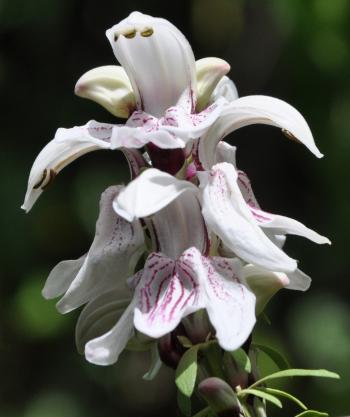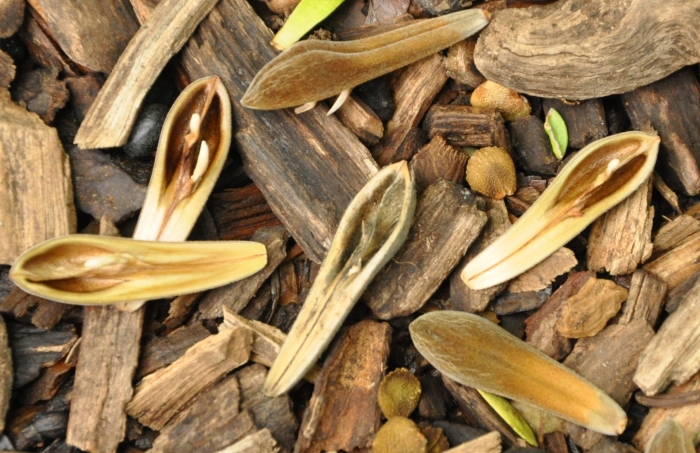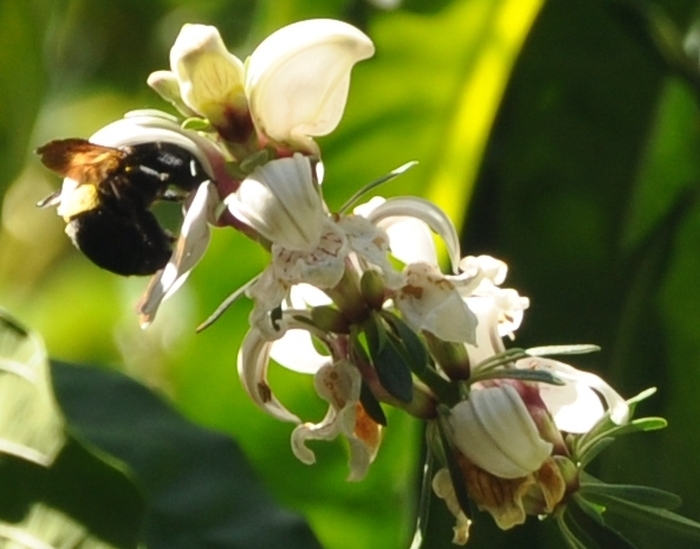Justicia adhatodoides
Justicia adhatodoides (E.Mey. ex Nees) V.A.W.Graham
Family: Acanthaceae
Common names: pistol bush (Eng.); pistoolbos (Afr.); ihlwalane, isepheka, ihlwehlwe (Xhosa); uthabe, lothabe (Zulu)
SA Tree No: 681
Introduction
A fast-growing, late summer-flowering shrub for semi-shade or sun, with showy and fragrant white flowers that show up well against its glossy dark green foliage. For many years it was known as Duvernoia adhatodoides.

Description
Description
Justicia adhatodoides is an evergreen shrub up to 3 m tall, or a small tree, 7–10 m in height. It can be single or multi-stemmed, and has a dense crown of dark green leaves. The bark is dark brown, rough and fissured. The branches are brittle. The leaves are large, oval- to lance-shaped and tapering to a point, up to 230 mm long and 150 mm wide, shiny dark green, with wavy margins.

The flowers are showy, white with mauve to purple markings and are borne abundantly in conspicuous heads in late-summer, autumn and winter (February to August). The flowers are two-lipped with a short tube. According to Palmer and Pitman, the flowers may be scented or without scent. Those growing in Kirstenbosch have a strong scent that is sweet to almost sickly, with a whiff of mothballs.

The fruit is a club-shaped capsule that turns brown when ripe and splits explosively with a loud crack, to release several flattish, wrinkled seeds. The capsules start ripening in autumn, and continue throughout winter into early summer (May to December).

Conservation Status
Status
Justicia adhatodoides is not threatened, and is thus assessed as Least Concern (LC).
Distribution and habitat
Distribution description
Justicia adhatodoides is found in forest, forest margins, along streams, in ravines and on rocky outcrops in Mpumalanga, KwaZulu-Natal and the Eastern Cape of South Africa, and in Swaziland, often in colonies, and often as an understorey shrub in forest.

Derivation of name and historical aspects
History
The genus Justicia is named after James Justice, 1698-1763, a Scottish horticulturalist. The species name adhatodoides means ‘resembling Adhatoda’ another former genus in the Acanthaceae, that contained many species of perennial herbs found in the Old World tropics, but only 2 in southern Africa. It earned its common name 'pistol bush', from the sharp cracking noise of its dehiscing seed capsules. The derivation of the former genus name Duvernoia is not explained, but is possibly named after J.G. Duvernoy, a German botanist and student of Tournefort, who wrote a Flora of Tübingen in 1722.
Duvernoia was, until recently, regarded as a separate genus of only 2 species, both now included in Justicia: J. adhatodoides and J. aconitiflora, the lemon or yellow pistol bush, a small shrub up to 3 m tall, found in Mpumalanga, KwaZulu-Natal, Swaziland and southern Mozambique, with two-lipped pale yellow to cream-coloured flowers in autumn. Justicia is a large and variable genus containing about 600 species spread throughout the world. The current thinking is to follow the broad view of Justicia, which now encompasses many smaller genera, including Adhatoda and Duvernoia, which are now sections within Justicia.
Justicia belongs in the Acanthaceae, a large family of over 2 000 species of mainly herbs, shrubs and climbers, widespread throughout the tropics. Other South African members of this family that are well known to gardeners, include Mackaya bella (forest bellbush), Barleria obtusa (bush violet), Hypoestes aristata (ribbon bush) and Thunbergia alata (black-eyed Susan). Justicia adhatodoides is unusual in its family, being one of the few that grows into a woody shrub or small tree.

Ecology
Ecology
The flowers are pollinated by carpenter bees (Xylocopa spp.), the process first described by Mrs M.E. Barber in the Journal of the Linnean Society, in 1871. The large bee lands on the lower lip of the flower and forces open the corolla tube with its wedge-shaped proboscis or beak to get at the nectar. In so-doing it holds onto the flower and forces its head and thorax into the flower, which pushes its hairy thorax against the upper lip of the flower, and against the style and stamens, which are positioned beneath the upper lip. Its thorax gets dusted with pollen. It then flies to and lands on another flower, where its thorax brushes against the stigma of that flower and transfers some of its load of pollen to it, while it picks up more pollen as it feeds, before moving on to the next flower. In this way the flowers are fertilized. When in flower at Kirstenbosch, they certainly are well-visited by carpenter bees, and birds have also been observed foraging among the flowers.

The seed capsules split explosively and scatter the seeds quite far from the mother plant. They germinate freely and form colonies both in the wild and in gardens where the seedlings are left to grow.
Uses
Use
The sapwood is white and narrow, and the heartwood is yellow, close grained and heavy with a beautiful surface. It earned the common name bastergeelhout, meaning ‘false yellowwood’ from the colour of its timber.
Justicia adhatodoides is not used in traditional medicine, but in the Eastern Cape it is used in the construction of traditional houses and is possibly also used to make household utensils.
Growing Justicia adhatodoides
Grow
Justicia adhatodoides is an excellent, fast-growing and decorative garden plant, with white flowers in late summer and attractive foliage all year. This species does best in a cool, moist site and is well-suited to coastal gardens, although it is best not exposed to strong, drying winds like Cape Town’s south-easter. It can be used as a background planting for the herbaceous border, in the shrubbery, as a screening plant or an informal hedge. Plant it in sun, semi-shade or light shade, in fertile, well-composted soil and water well, particularly during its spring-summer growing season. It is sensitive to frost, but can be grown in cold areas where frost is not too severe, as long as it is protected. Plants growing in semi-shade, tend to have more lush and deeper green foliage, but those in a more sunny position, flower better. Prune to shape or to maintain as a shrub.
Propagate Justicia adhatodoides by seed or cuttings.
Seed germinates readily. Sow fresh seed in spring or summer and keep moist and warm in a shaded position. Since the seeds are released explosively, collecting them requires repeat visits while they are ripening, and remember to place the capsules in a container with a sturdy lid, to prevent the seeds from being scattered to all corners of the drying room, or bag the fruiting heads on the mother plant. At Kirstenbosch the plants seed themselves freely in the Arboretum, thus seedlings can also be transplanted from around the base of a plant that is left to go to seed.
Take semi-hardwood heel cuttings, using side shoots in early summer, treat with rooting hormone, use a well-aerated weed-free potting medium and place in a propagation unit with mist and underbench heating of 20–24ºC.
Pot the seedlings and rooted cuttings into a good, fertile, loamy soil and fertilize and water well to stimulate growth. Grow on in light shade and keep out of direct or strong sunlight, until they are established.
References
- Barber, M.E. 1871. On the fertilization and dissemination of Duvernoia adhatodoides. Journal of the Linnean Society of London (Botany) 11(56): 469–472.
- Boon, R. 2010. Pooley's trees of eastern South Africa, a complete guide. Flora & Fauna Publications Trust, Durban.
- Coates Palgrave, K. 1983. Trees of southern Africa, 2nd Revised Edn. Struik Publishers, Cape Town, Johannesburg.
- Jackson, W.P.U. 1990. Origins and meanings of names of South African plant genera. University of Cape Town.
- Kamundi, D.A. 2006. Duvernoia adhatodoides E.Mey. ex Nees. National Assessment: Red List of South African plants version 2014.1. Accessed on 2015/02/19.
- Leistner, O.A. (ed.). 2000. Seed plants of southern Africa: families and genera. Strelitzia 10. National Botanical Institute, Pretoria.
- Palmer, E. & Pitman, N. 1972. Trees of southern Africa. Balkema, Cape Town.
- Tewari, D.D. 2012. Promoting non-timber forest products (NTFPs) to alleviate poverty and hunger in rural South Africa: A reflection on management and policy challenges. African Journal of Business Management 6(47): 11635–11647.
- Goldblatt, P. & Manning, J.C. 2014. Nomenclatural adjustments in African plants 1. Bothalia 44(1) 9 pages.
Credits
Alice Notten
Kirstenbosch National Botanical Garden
March 2015, updated July 2019
updated and expanded on March 2001 Plant of the Week article by Giles Mbambezeli, Kirstenbosch NBG
Plant Attributes:
Plant Type: Shrub, Tree
SA Distribution: Eastern Cape, KwaZulu-Natal, Mpumalanga
Soil type: Sandy, Loam
Flowering season: Late Summer, Autumn, Winter
PH:
Flower colour: White, Mauve/Lilac
Aspect: Full Sun, Shade, Morning Sun (Semi Shade), Afternoon Sun (Semi Shade)
Gardening skill: Easy
Special Features:
Horticultural zones











Rate this article
Article well written and informative
Rate this plant
Is this an interesting plant?
Login to add your Comment
Back to topNot registered yet? Click here to register.